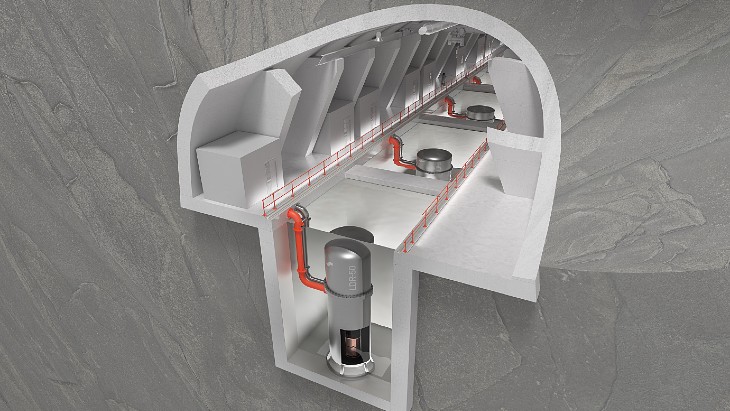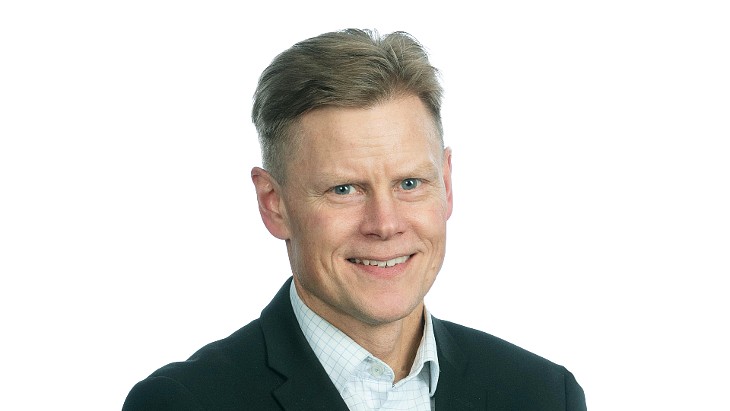Steady Energy was spun out of Finland's state-owned VTT Technical Research Centre in 2023 and is developing the LDR-50 small modular reactor with a thermal output of 50 MW, designed to operate at around 150°C. Unlike nearly all the other small modular reactors being developed around the world, it is not designed to generate electricity - or electricity and heat. Instead it is designed to only produce heat.
Nyman is by background a mechanical engineer who worked at CERN, including on the Higgs Boson project, and then 15 years at Finnish utility TVO including time on the project management team for Olkiluoto 3 and more recently at VTT, Finland's national labs. He joined the World Nuclear News podcast to explain the thinking behind the LDR-50. Here are edited quotes from his interview:
The birth of the idea for a heat-only SMR
"The ambition at VTT was to bring innovations to life and not just to create science papers ... Our researchers found out that almost 10% of all CO2 emissions originated from heating up water or steam to 150°C. We at VTT were interested to find markets where nuclear energy could be most economically exploited. The innovation of the LDR-50 was born from the concept of 'why not build something simple that would only cover low temperature heat markets'. In the context of the climate crisis, nuclear is a very good option but the problem has been getting projects economically sound so that nuclear can be utilised without large subsidies. We know that the most economical way to use nuclear is just to generate thermal energy without using the heat to create electricity. So this is what the origin of the innovation was - why not build a reactor only for heating purposes."
 How the LDR-50 might look (Image: Steady Energy)
How the LDR-50 might look (Image: Steady Energy)
What are the advantages of an SMR only producing heat?
"Simplicity is the cornerstone of our technology. We returned back to basics and we build on all the knowledge and technologies that are available out there. Simplicity leads us to tackle the economic constraints that there are for our clients and markets - utilities and municipal energy organisations. The product has to fit in their investment portfolio. By only producing heat you can reduce the amount of equipment in a nuclear power plant by 50% and the technical conditions are more bearable, especially when you concentrate on low temperature heat - what we call 150°C and below. The operating pressure (below 10 bar/145 psi) in the reactor vessel is 20 times lower than in those reactors designed for electricity production (similar levels to an Espresso machine), so the thickness of the pressure vessel is only a few centimetres whereas in larger reactors it is 20 centimetres. This makes the cost structure much simpler and economical."
What about the cost of the heat?
"The cost of energy we are aiming for is below EUR40 per MWh, depending on how the utility wants to operate it. Remember that we utilise almost 100% of the energy that is produced by the reactor whereas in a reactor where you produce electricity you lose 60% of your energy as losses and decay heat."
What are the benefits of district heating schemes?
"A district heating network is built typically underground, delivering heated water or in some cases steam to houses where each house or blocks of homes have their own heat exchanger which then distributes the heat to individual households. These are long-living infrastructures analogous to electric cables. There are more than 17,000 heating networks in Europe but, typically, they are not visible and not very well known because you get the heat to your home without thinking about where it's coming from. It's an efficient way of delivering home heat as it can be centralised and you can benefit from economies of scale. In Europe there has been discussion about increasing the usage of district heating, maybe tripling the number of networks. So the current 24 million homes heated by such networks could be increased to 80 million."
 Tommi Nyman (Image: Steady Energy)
Tommi Nyman (Image: Steady Energy)
What would be the climate impact of decarbonising district heating?
"We have counted that we have over 60 million tonnes of CO2 emissions reduction immediately available by decarbonising those networks that we have identified in the most promising markets, like Finland, Sweden and Poland. These are remarkable amounts and if you count all CO2 emissions reduction potential from heating up water to 150°C that would then be a gigatonne scale of CO2 reduction. Helen, the municipal company of Finland's capital city has set out a strategy to stop using fossil fuels and biomass and combustion in general in the 2030s. With this kind of strategy to address CO2 emissions then nuclear heating is really borne out as a very, very promising solution. We have in fact signed a letter of intent to build up to 10 reactors in Helsinki alone."
What is the planned timeline?
"We have a road map that brings us first to a pilot plant, which will be a one-to-one scale reactor module with electric resisters, so it is like an electric boiler, but its purpose is to demonstrate the thermal hardware behaviour of the boiler. Because it is one-to-one scale we also want to get proof of the supply chain being able to deliver. We want to begin construction of the pilot plant next year and are now in the phase of selecting a construction site. At the same time we are preparing our concept assessments and taking the necessary regulatory steps. We hope to sign a first plant contract in 2028 to deliver our first plant in operation by 2030."
What about regulatory hurdles?
"In Finland, there are not such big regularly hurdles. It's just the engineering that we have to go through and demonstrate that our simplified reactor functions as it should. We can locate a plant very close to the existing networks, even within cities. There used to be a categorical requirement of having a 5-kilometre exclusion zone around any nuclear plant but now the regulation takes a different angle. We have to demonstrate that we can reach similar levels of safety with shorter distances. We also build our plants underground, in the bedrock, with passive safety systems, so the exclusion zone on the surface is virtually the fenced area that we use to access the plant. There might be some slower progress on the planning side of how and where the plants can be built because of the municipal process - zoning etc."
What about other applications beyond district heating?
"Desalination is one interesting option, and beyond that industrial heat. Those factories where the use of thermal energy is key in drying processes or sterilisations - medical industry, food, pulp and paper - they use steam or water which is heated up to about 100°C so that brings another large market for us. We have to start raising knowledge about this and capturing new markets for nuclear. People typically associate nuclear with electricity. So that's a marketing exercise for us, to bring the understanding that you can have access to a clean and economical heat with nuclear energy. We also want to make it simple for potential clients, so we don't only sell the plants but we also offer a service contract on top of it, all the way through to the geological disposal of the spent fuel."
On the general outlook for nuclear
"The world has changed very rapidly in recent years and nuclear energy now has a place in the negotiations and discussions about what could help us in the future as an energy source. We are now here to capture new markets for nuclear helping people see that the benefits of nuclear can be quite fast. Still 80% of all energy today is coming from fossil fuels, but now there is rising hope that we can bring new solutions to solve this dilemma."
* Also in this edition of the World Nuclear News podcast, the news update features developments in India, South Africa and uranium production in the USA. Listen and subscribe on all major podcast platforms
World Nuclear News podcast homepage
Spotify
Apple
Amazon Music




_47120.jpg)

_23621.jpg)




